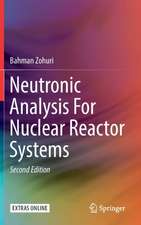Knowledge is Power in Four Dimensions: Models to Forecast Future Paradigm: With Artificial Intelligence Integration in Energy and Other Use Cases
Autor Bahman Zohuri, Farhang Mossavar Rahmani, Farahnaz Behgouniaen Limba Engleză Paperback – 12 iul 2022
A final section deliver the most advanced content on artificial intelligence with the integration of machine learning and deep learning as a tool to forecast and make energy predictions. The reference covers many introductory programming tools, such as Python, Scikit, TensorFlow and Kera.
- Helps users gain fundamental knowledge in technology infrastructure, including AI, machine learning and fuzzy logic
- Compartmentalizes data knowledge into near-term and long-term forecasting models, with examples involving both renewable and non-renewable energy outcomes
- Advances climate resiliency and helps readers build a business resiliency system for assets
Preț: 921.67 lei
Preț vechi: 1193.60 lei
-23% Nou
Puncte Express: 1383
Preț estimativ în valută:
176.37€ • 188.59$ • 147.05£
176.37€ • 188.59$ • 147.05£
Carte tipărită la comandă
Livrare economică 10-24 aprilie
Preluare comenzi: 021 569.72.76
Specificații
ISBN-13: 9780323951128
ISBN-10: 0323951120
Pagini: 998
Dimensiuni: 191 x 235 mm
Greutate: 1.68 kg
Editura: ELSEVIER SCIENCE
ISBN-10: 0323951120
Pagini: 998
Dimensiuni: 191 x 235 mm
Greutate: 1.68 kg
Editura: ELSEVIER SCIENCE
Public țintă
Energy engineers; electrical engineers; data scientists; environmental engineers; alternative energy researchersCuprins
Part I: Infrastructure Concepts
1. Knowledge is Power
2. A General Approach to Business Resilience System (BRS)
3. Data Warehousing, Data Mining, Data Modeling, and Data Analytics
4. Structured and Unstructured Data Processing
5. Mathematical Modeling Driven Predication
6. Fuzzy Logics: A New Method of Predictions
7. Neural Network Concept
8. Population - Human Growth Driving Ecology
9. Economic Factors
10. Risk Management, Risk Assessment, and Risk Analysis
11. Today’s Fast-Paced Technology
Part II: The Impact of Energy on Tomorrow’s World
12. Understanding of Energy
13. Economic Impact of Energy
14. Renewable Energy
15. Non-Renewable Energy
16. Nuclear Energy as Non-Renewable Energy Source
17. Energy Storage Technologies and their Role in Renewable Integration
Part III: The Mathematical Approach and Modeling
18. Predictive Analytics
19. Engineering Statistics
20. Data and Data Collection Driven Information
21. Statistical Forecasting - Regression and Time Series Analysis
22. Introduction to Forecasting: The Simplest Models
23. Notes on Linear Regression Analysis
24. Principles and Risks of Forecasting
25. Artificial Intelligence Driving Predictive and Forecasting Paradigm
Part IV: Python Programming Driven Artificial Intelligence
26. Python Programming Driven Artificial Intelligence
27. Artificial Intelligence, Machine Learning and Deep Learning Driving Big Data
28. Artificial Intelligence, Machine Learning and Deep Learning Use Cases
1. Knowledge is Power
2. A General Approach to Business Resilience System (BRS)
3. Data Warehousing, Data Mining, Data Modeling, and Data Analytics
4. Structured and Unstructured Data Processing
5. Mathematical Modeling Driven Predication
6. Fuzzy Logics: A New Method of Predictions
7. Neural Network Concept
8. Population - Human Growth Driving Ecology
9. Economic Factors
10. Risk Management, Risk Assessment, and Risk Analysis
11. Today’s Fast-Paced Technology
Part II: The Impact of Energy on Tomorrow’s World
12. Understanding of Energy
13. Economic Impact of Energy
14. Renewable Energy
15. Non-Renewable Energy
16. Nuclear Energy as Non-Renewable Energy Source
17. Energy Storage Technologies and their Role in Renewable Integration
Part III: The Mathematical Approach and Modeling
18. Predictive Analytics
19. Engineering Statistics
20. Data and Data Collection Driven Information
21. Statistical Forecasting - Regression and Time Series Analysis
22. Introduction to Forecasting: The Simplest Models
23. Notes on Linear Regression Analysis
24. Principles and Risks of Forecasting
25. Artificial Intelligence Driving Predictive and Forecasting Paradigm
Part IV: Python Programming Driven Artificial Intelligence
26. Python Programming Driven Artificial Intelligence
27. Artificial Intelligence, Machine Learning and Deep Learning Driving Big Data
28. Artificial Intelligence, Machine Learning and Deep Learning Use Cases


















